Six spooky Halloween sights from the boundless depths of space

The universe contains many spooky and creepy sights within its unending depths that are perfect for the Hallowe'en season!
When we look out into the cosmos, one thing we don't typically expect is to find something looking back at us! However, over the years, telescopes and spacecraft have found many objects, near and far, which appear to be doing just that!
Solar Jack-o'-Lantern

This image of the Sun's photosphere was captured by NASA's Solar Dynamics Observatory (SDO) on October 8, 2014. Credit: NASA
On October 8, 2014, while everything appeared fairly quiet on the Sun, with only a few small sunspots marring the surface of its photosphere, something else was lurking deeper in the spectrum of ultraviolet light.
Shifting our view into higher energy wavelengths of light, courtesy NASA's Solar Dynamics Observatory, revealed a hidden jack-o'-lantern grinning at us.

This image is a blend of two wavelengths of extreme ultraviolet light, as captured by SDO at roughly the same moment as the photosphere image, above. Credit: NASA
According to NASA: "The active regions in this image appear brighter because those are areas that emit more light and energy. They are markers of an intense and complex set of magnetic fields hovering in the Sun's atmosphere, the corona. This image blends together two sets of extreme ultraviolet wavelengths at 171 and 193 Ångströms, typically colourized in gold and yellow, to create a particularly Halloween-like appearance."
"The Eye of Sauron"
One of the brightest stars in the sky goes by the name Fomalhaut (or more formally, Alpha Piscis Austrini).
This young star has many mysteries surrounding it, quite literally, as it appeared to have a massive exoplanet that suddenly vanished in 2020. However, the first image of it from the Hubble Space Telescope, in 2004, revealed that it bore an uncanny resemblance to an icon of fantasy literature — the lidless, flaming Eye of Sauron, from J.R.R. Tolkien's Lord of the Rings.
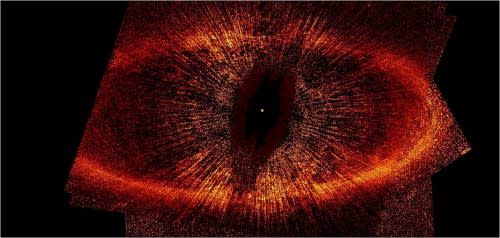
The Fomalhaut star system, roughly 25 light years away from Earth. Credit: NASA, ESA, P. Kalas And J. Graham (University of California, Berkeley) and M. Clampin (NASA/GSFC)
"You know of what I speak, Gandalf. A great eye, lidless and wreathed in flame." — Saruman the White to Gandalf the Grey. Lord of the Rings: The Fellowship of the Ring.
"The Eye of God"
Far out in space, another 'eye' stares back at us.
Around 10,000 years ago, a star very much like our Sun, located in the constellation Aquarius, had grown into a swollen unstable red giant star. As it reached the end of its lifespan, it cast off its outer layers into space, which formed an immense shell around it, in the shape of a flattened sphere. The resulting object, which has been measured at over five light years across, is known as the Helix Nebula.

The Helix Nebula. Credit: NASA, ESA, and C.R. O'Dell (Vanderbilt University)
From our perspective here on Earth, we are essentially looking at an immense bubble in space. Since the edge of the bubble is fairly thin compared to the size of the nebula, we can see through it into the relatively empty space inside. Meanwhile, the material along the edges show up much more clearly to us.
So, the nebula ends up looking like a great eye to us. Some have called this another Eye of Sauron, while others have nicknamed it the Eye of God.
A skull in the stars
Far out in the universe, hundreds of millions of light years away from Earth, is the Perseus Cluster, an enormous grouping of galaxies that counts among the most massive objects in the known cosmos.
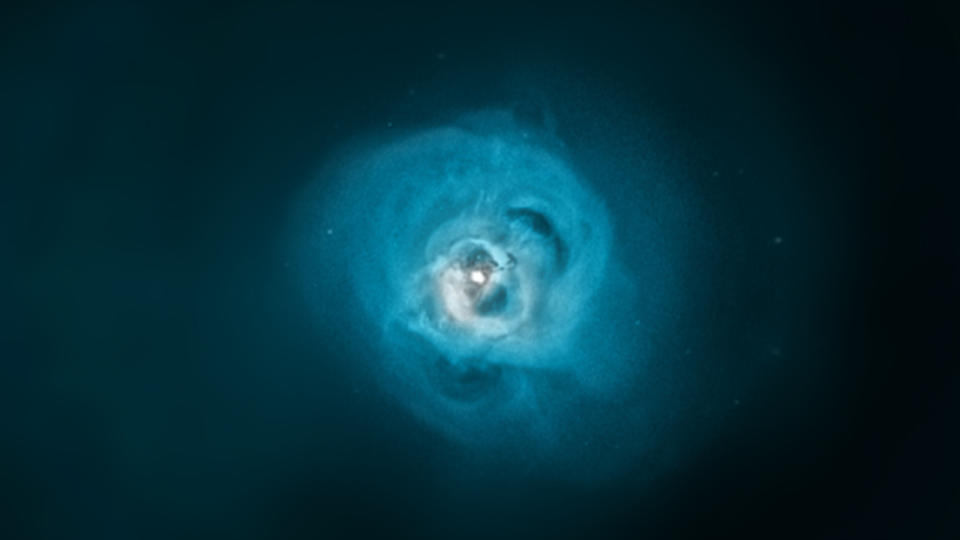
The Perseus Galaxy Cluster. Credit: A. Fabian (IoA Cambridge) et al., NASA
While the x-ray image of the Perseus Cluster, above, gave astronomers a tantalizing glimpse at what might be dark matter, rotating the image revealed something else...
A horrifying skull in the midst of a silent scream.
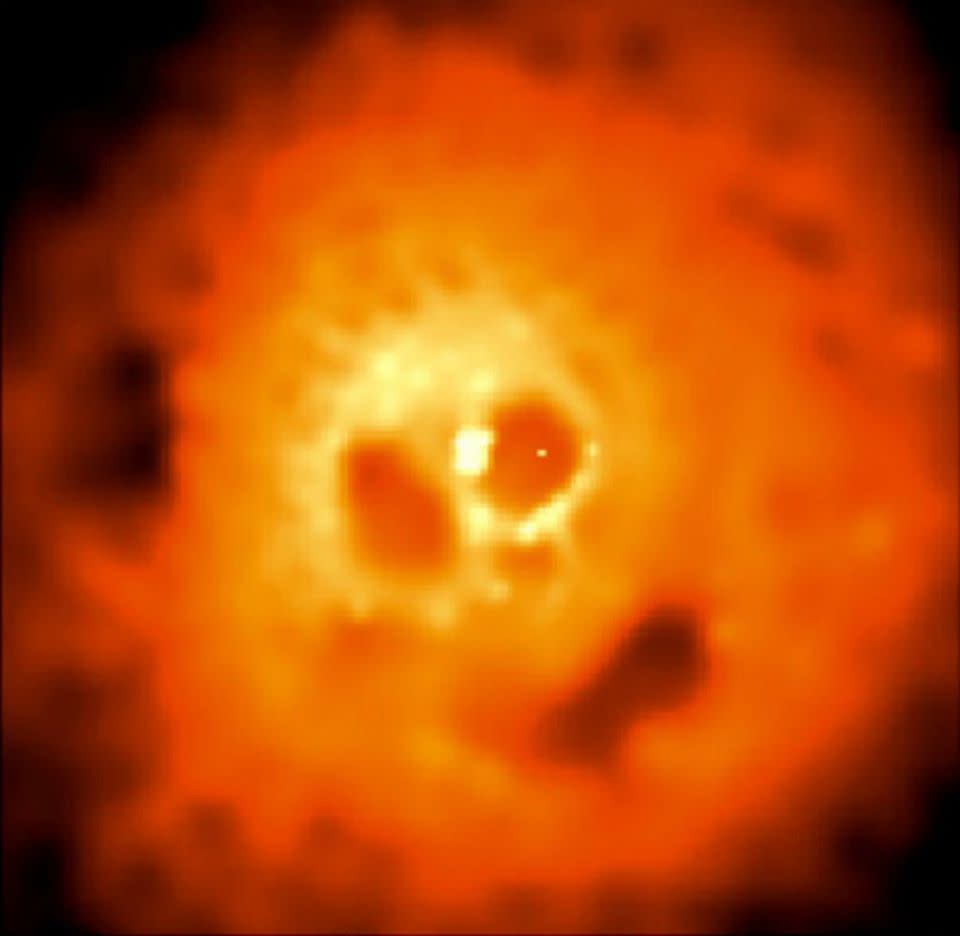
The Screaming Space Skull. Credit: A. Fabian (IoA Cambridge) et al., NASA
According to NASA: "This haunting image from the orbiting Chandra Observatory reveals the Perseus Cluster of Galaxies in x-rays, photons with a thousand or more times the energy of visible light. Three hundred twenty million light-years distant, the Perseus Cluster contains thousands of galaxies, but none of them are seen here. Instead of mere galaxies, a fifty million degree cloud of intracluster gas, itself more massive than all the cluster's galaxies combined, dominates the x-ray view. From this angle, voids and bright knots in the x-ray hot gas cloud lend it a very suggestive appearance. Like eyes in a skull, two dark bubbles flank a bright central source of x-ray emission. A third elongated bubble (at about 5 o'clock) forms a toothless mouth."
Hallowe'en Asteroid
Closer to home, on Halloween in 2015, a large asteroid named 2015 TB145 slipped by Earth at a distance of just 488,000 kilometres, or about 100,000 km farther away than the Moon.
While this was a completely safe pass of this asteroid, as it flew by, scientists used the Arecibo Observatory in Puerto Rico to bounce radar waves off its surface to return an image of what it looked like.
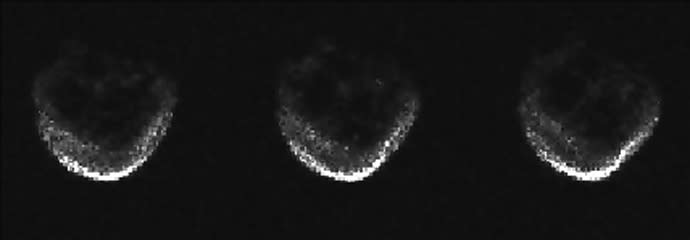
Asteroid 2015 TB145 as imaged by Arecibo radar. Credit: Arecibo/NSF
Part-way into the observations, astronomers watched as this 600 metre-wide space rock turned a skull-like visage towards us.

Credit: Arecibo/NSF
Dubbed the Halloween Asteroid it was revealed to be fairly special, because it may be a dead comet.
Comets are immense chunks of ice, dust, gas, and rock, which are left over from the formation of the solar system. When a comet draws closer to the Sun, it sends streamers of gas and dust out into space, forming a cloud around it known as the coma, as well as two long tails, one made of dust and the other of ionized gas. Each repeated trips around the Sun causes the comet to lose more ice and gas and dust, and if it does this enough times, it can run out of these resources. What's left behind is a rocky remnant that may be the original nucleus around which the comet formed, long ago.
Now, despite its appearance, asteroid 2015 TB145 is certainly not the leftover skull of some immense celestial being. Instead, the 'face' is simply a result of our tendency to pick out faces in objects ('pareidolia'), as we see the shadowed craters and pits in the asteroid's lumpy surface.
New for 2023, the "Face of Jupiter"
NASA's Juno spacecraft has been orbiting the planet Jupiter for over seven years now. In that time, the probe has made 55 close passes around the gas giant (called 'perijoves'), snapping pictures of the planet's swirling cloud bands and even its largest moons on each flyby.
During Juno's 54th perijove, on September 7, 2023, JunoCam captured a strange and spooky sight as it swept over one of the far northern regions known as Jet N7.
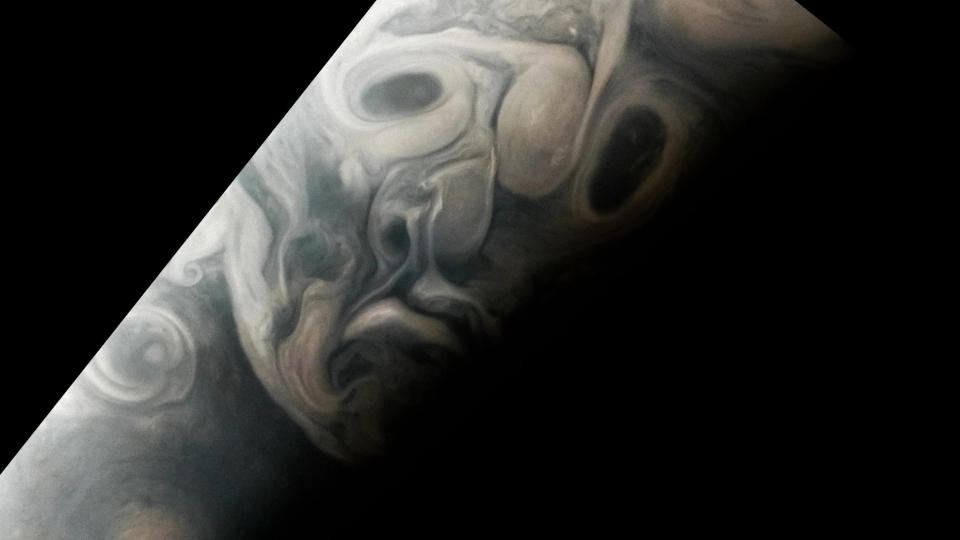
According to NASA: "The image shows turbulent clouds and storms along Jupiter's terminator, the dividing line between the day and night sides of the planet. The low angle of sunlight highlights the complex topography of features in this region, which scientists have studied to better understand the processes playing out in Jupiter's atmosphere. As often occurs in views from Juno, Jupiter's clouds in this picture lend themselves to pareidolia, the effect that causes observers to perceive faces or other patterns in largely random patterns. Citizen scientist Vladimir Tarasov made this image using raw data from the JunoCam instrument. At the time the raw image was taken, the Juno spacecraft was about 4,800 miles (about 7,700 kilometers) above Jupiter's cloud tops, at a latitude of about 69 degrees north."
While it's fun to think of these creepy cosmic sights, there is far more out in the universe that can inspire awe and wonder. Unlocking the secrets behind what we see can lead to answers to some of the most fundamental question of our existence, such as "why are we here", and "are we alone?"
For more cosmic treats (and no tricks), head to The Weather Network's Space news page, and have a Happy Hallowe'en!

